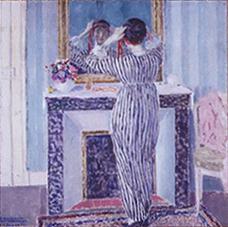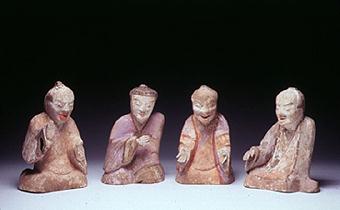|
AMERICAN IMPRESSIONIST PANTING BY FRIESEKE Also Included Are Fall-Front Desk, Chinese Game Figures, An American Impressionist painting by Frederick Carl Frieseke, an early 19th-century fall-front desk, a set of four Han Dynasty game figures from China, an early 20th-century clock by Austrian designer Josef Hoffmann, and an early 19th-century Indian miniature painting have been added to the permanent collection of the Virginia Museum of Fine Arts. In addition, a number of works from the estate of Paul Mellon of Upperville [Va.] -including five paintings by British artist George Stubbs - have been accepted as gifts. The acquisitions were approved by the executive committee
of the museum's board of trustees this month.  Photo by Katherine Wetzel © Virginia Museum of Fine Arts.
"We are thankful for the extraordinary care and generosity
that Paul Mellon has shown this institution and for the generous
privately donated funds that allow our professional curators
to make meaningful purchases that expand the impact of the museum's
holdings."
"Blue Interior: Giverny (The Red Ribbon)," ca. 1912-13,
an oil on canvas by American artist Frederick Carl Frieseke (1874-1939).
The painting, which measures 32 inches square, depicts a young
model standing before a mirror to adjust a red ribbon in her
hair. Painted in the little French hamlet made famous by artist
Claude Monet, "Blue Interior" was executed at the height
of the artist's career and given to friends in Giverny. It has
remained hidden from public view until recently, when the original
owner's descendants brought it to market, according to Dr. David
Park Curry, the museum's A fall-front desk, ca. 1820-25, made in New York of rosewood veneer and ornamented with gilded wood, cut-brass banding, cast and gilded brass mounts, a marble top and gilt-stamped leather. Just over five feet tall, the desk is from a group of high-style case pieces made in an as yet unidentified New York shop. The pieces shed light on the gradually unfolding complexities of the New York cabinetmaking trade from 1800 to 1825. The desk allows the museum to "push back the 'French connection' in American art and culture by half a century," Dr. Curry says. The piece is now on view.
 Rosewood, partially gilded marble top. Photo by Katherine Wetzel © Virginia Museum of Fine Arts
A set of four liubo game figures from Han Dynasty China, ca. 1st century BC-lst century AD, made of earthenware with pigment. Liubo was one of the most popular games in the Han Dynasty. It is played between two people using dice, counters, gaming pieces and a board. The museum's four figures capture a heated moment in a liubo game, according to Dr. Jason Sun, the museum's E. Rhodes and Leona B. Carpenter Curator of East Asian Art. Each of the figures stands just over a foot tall. The set "is the most intact and spectacular among all known examples," Dr. Sun says. A table clock, 1903-04, designed by Josef Hoffmann (Austrian, 1870-1956) and executed by silversmith Karl Kallert (Austrian, dates unknown) for the Wiener Werkstätte (1903-1932). Made of hammered sheet copper, alabaster, silver and coral, the clock stands just over a foot tall and complements a number of very important objects designed by Hoffmann that are already in the museum's Sydney and Frances Lewis Decorative Arts Collection, according to Frederick R. Brandt, the museum's consulting curator for 20th-century design and decorative arts. Calling it an "extraordinary" work, Brandt says the clock is "a masterful example by the leading Austrian designer and architect of his day."  Photo by Katherine Wetzel © Virginia Museum of Fine Arts.
"Shiva Ardhanarishvara," ca. 1810, and opaque watercolor
with gold on paper from "New York, 1997," 1997, an Ektacolor print by photographer Philip-Lorca diCorcia (American, b. 1953) from an unnumbered edition of 15. A part of the artist's "Street Series," the photograph measures 25-1/8 by 37-5/16 inches and was commissioned by The New York Times Magazine for an article on Times Square. It depicts evening rush hour on 42nd Street and evokes thoughts of the isolation of individuals "as they move through the decaying heart of the city during its transformation from red-light district to glitzy tourist destination," says John B. Ravenal, the museum's curator of art after 1900. The work will be on view following the grand reopening of the Lewis Galleries in April 2000. "Standing Female," 1916, a drawing in pencil and colored pencil on paper by Alexander Archipenko (American, b. Kiev, 1887-1964). Archipenko was a pioneer of early modem sculpture and was hailed as an innovator in form and materials, Ravenal says. Cubist drawings by Archipenko are rare, and one such as "Standing Female" is particularly desirable, according to Ravenal. It dates from the height of the artist's most original period in Paris and embodies the formal innovations of the artist's three-dimensional work. It is the first work by Archipenko to enter the museum's collection. The museum expects the work to be on view beginning in April 2000. A mask ensemble of a Kuosi Society member, from the Bamileke
culture (Cameroon), in mixed media. The ensemble would have been
worn by a man of high status at special gatherings of the society
and important state ceremonies, according to Richard B. Woodward,
the museum's curator of African art. It comprises a cotton tunic
- richly trimmed with Colobus monkey fur and red felt -and a
bead-studded cloth mask with floppy ears and long panels representing
an elephant's trunk, together with a large, beaded fly whisk
and a feathered hat. The tunic is the first textile work from
Cameroon to enter the museum 5 collection. A chess set in a covered box, 1924, by Josef Hartwig (German,
1880-1956) for the Bauhaus in Dessau (1919-1928), made of natural
and stained black pearwood. The 32 individual pieces in the chess
set vary in size, but the box measures 2_ by 5 by 5 inches. "The
Josef Hartwig chess set in its original
A gift from the estate of Paul Mellon, including 42 British
sporting paintings, 12 French drawings and 19 sculptures, the
latter mostly French. The  Photo by Richard Caspole, Yale Center for British Art © Virginia Museum of Fine Arts.
"The Dead Doll," 1954, by Ivan Albright (American, 1897-1983), an unnumbered lithograph on cream wove paper from an edition of 44. Albright, who painted the picture of the aged Dorian Gray in the 1947 MGM movie, considered "The Dead Doll" to be one of his most important works It is "an excellent example of his unique style, technical virtuosity and thematic exploration," says Ravenal. The lithograph is the first work by Albright to be added to the museum's collection. It measures 17_ by 251A inches and was given to the museum by Gabe Wharton Burton in honor of Dorothy Haas Rautbord and in memory of Ryerson Williams Potter. "The Poet" from "The Blue Guitar" series, 1977, by David Hockney (British, b. 1937), a five-color, hard ground and aquatint etching on mould-made paper, number 141 of an edition of 200. Hockney has been an important figure in contemporary art since his emergence in the 1960s. Ravenal calls the etching "spare and elegant." The series was inspired by the Wallace Stevens poem, "The Blue Guitar." It was given to the museum by Mr. and Mrs. Joseph Awad of Richmond. |